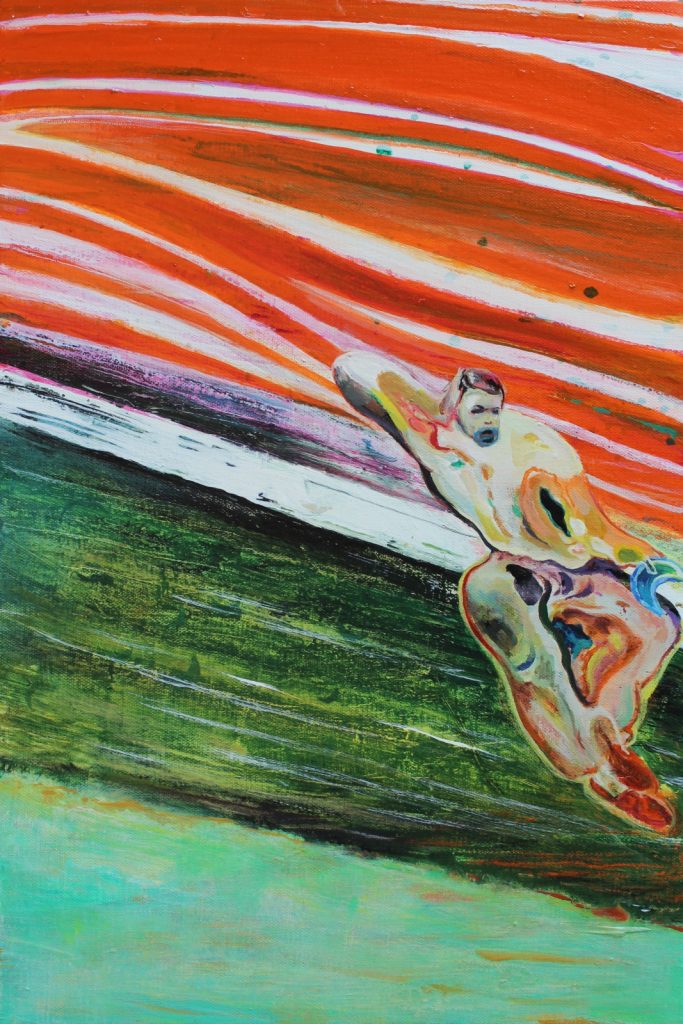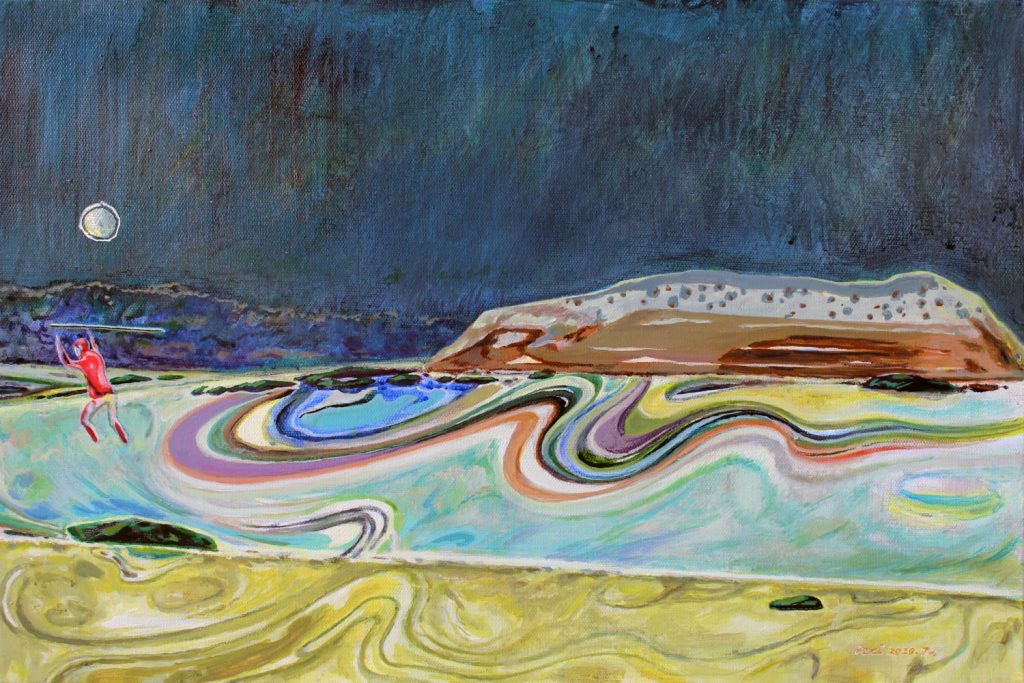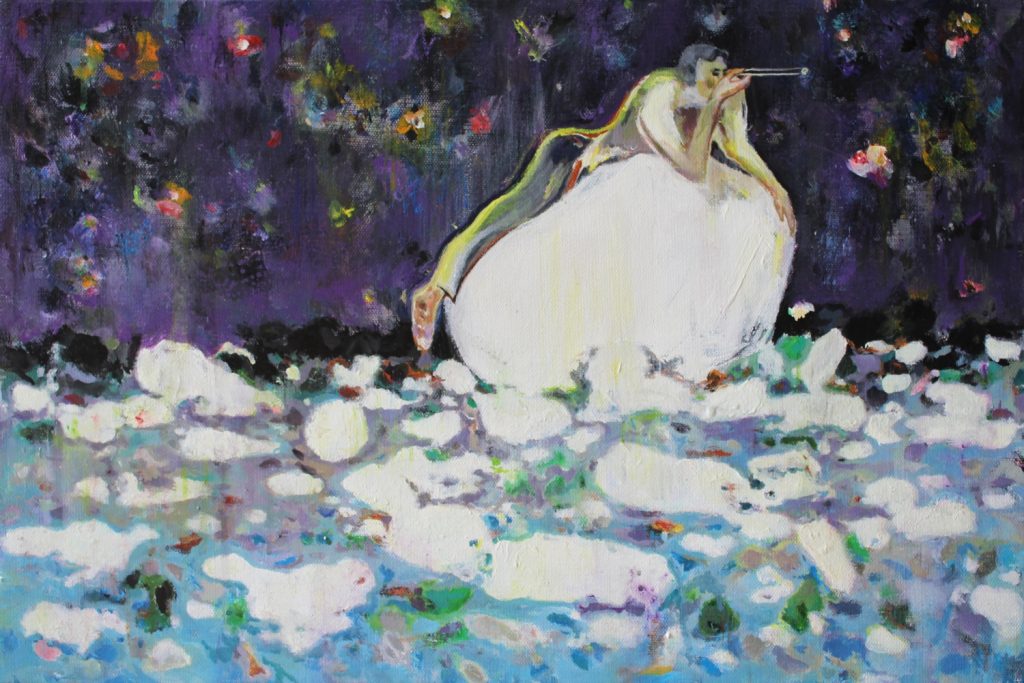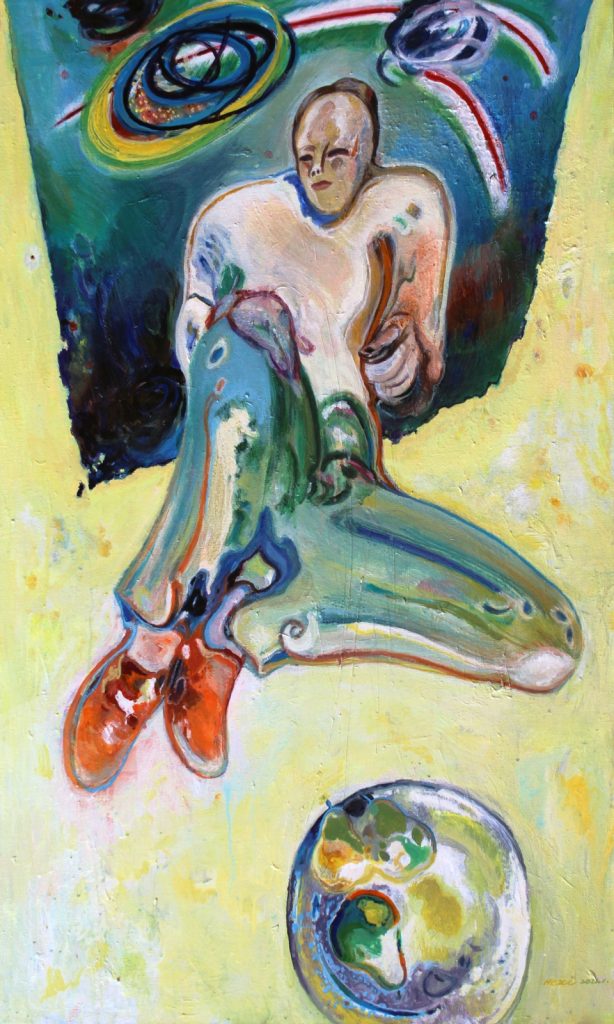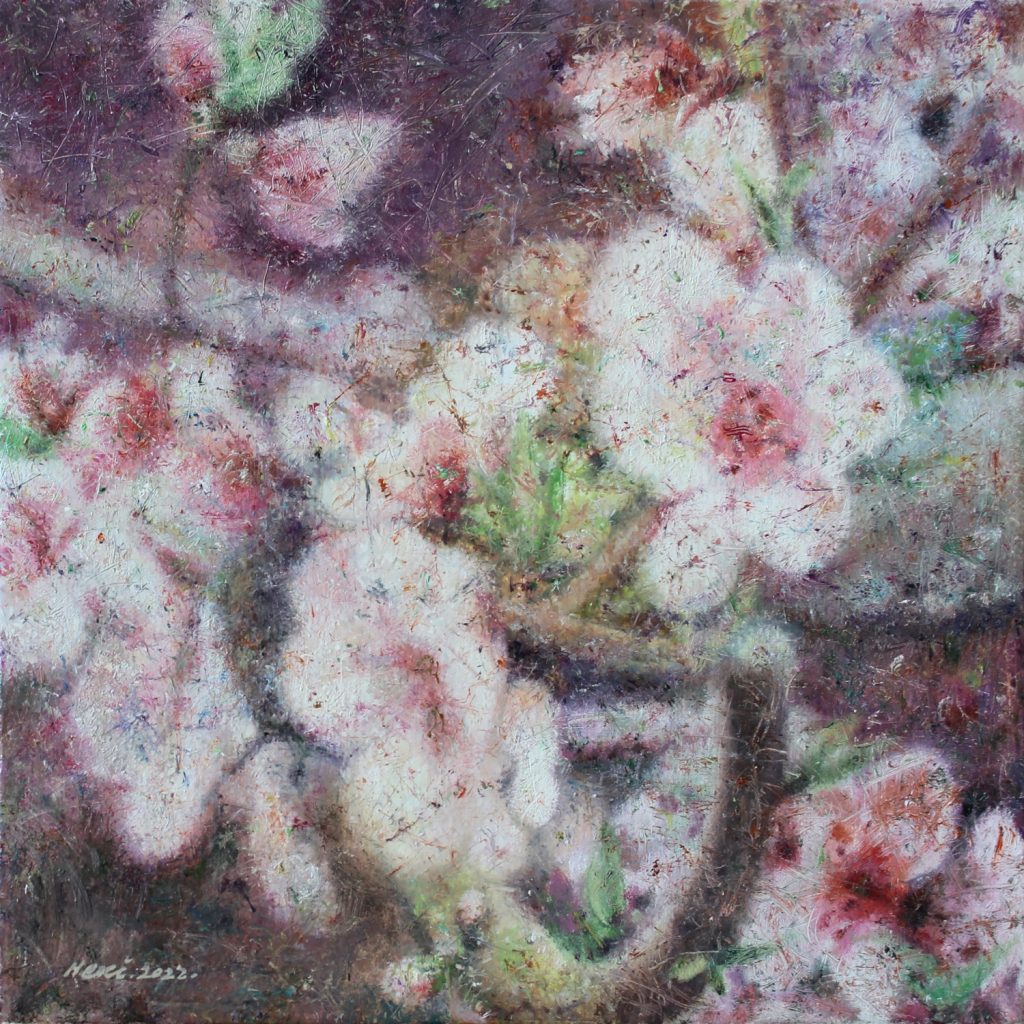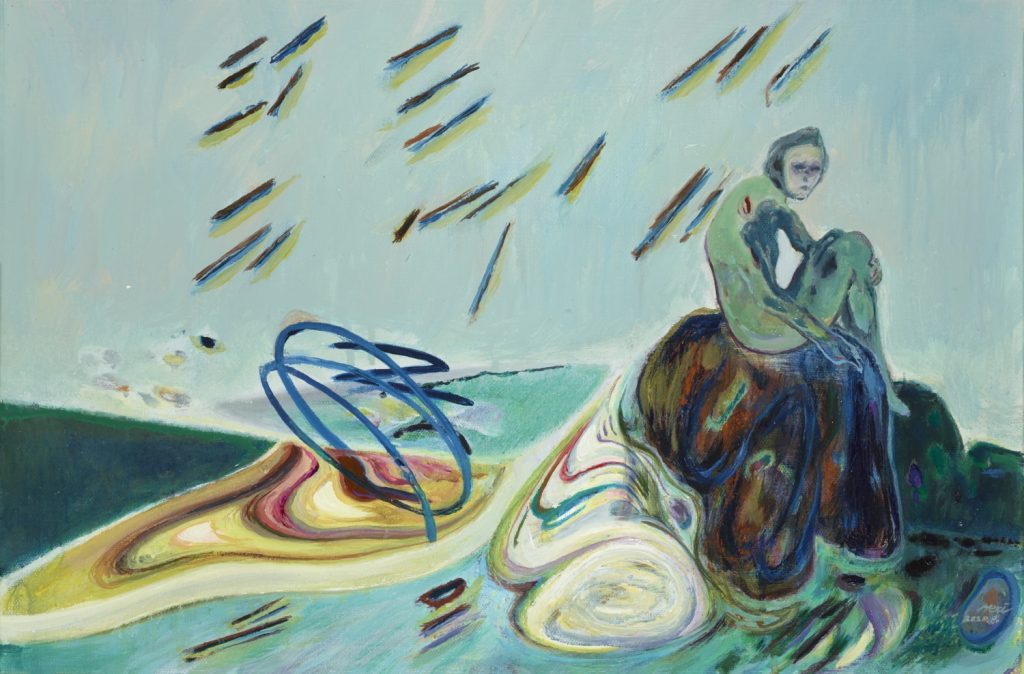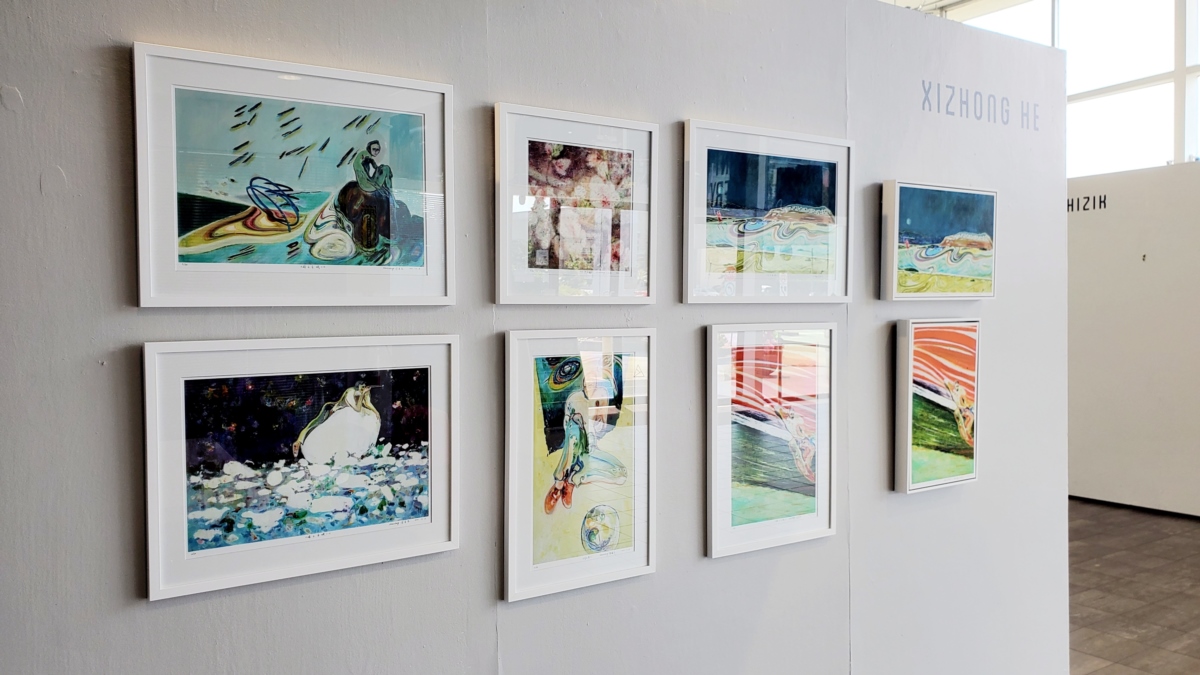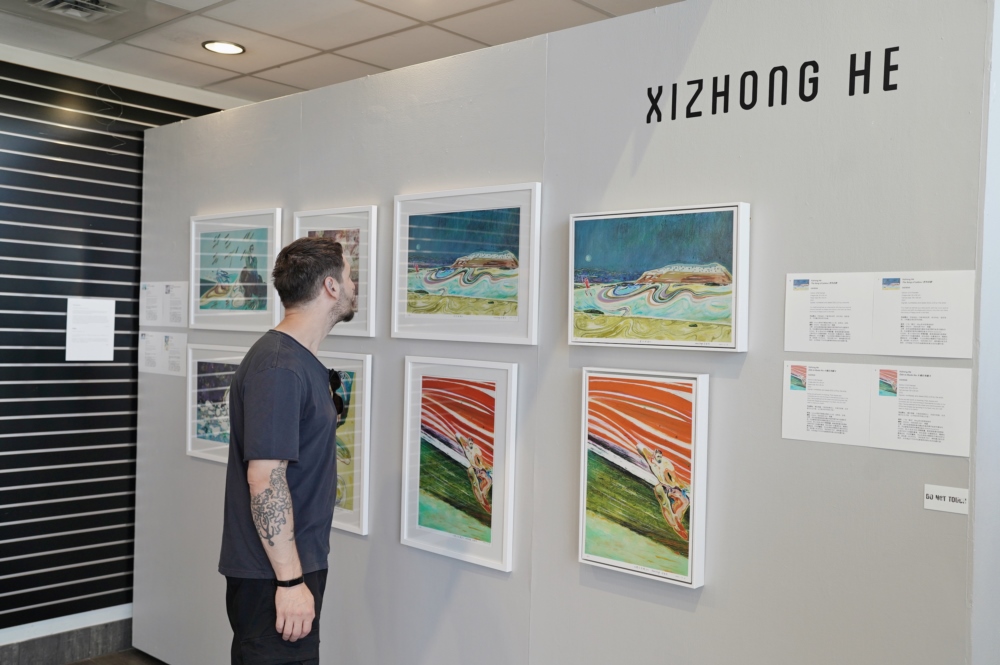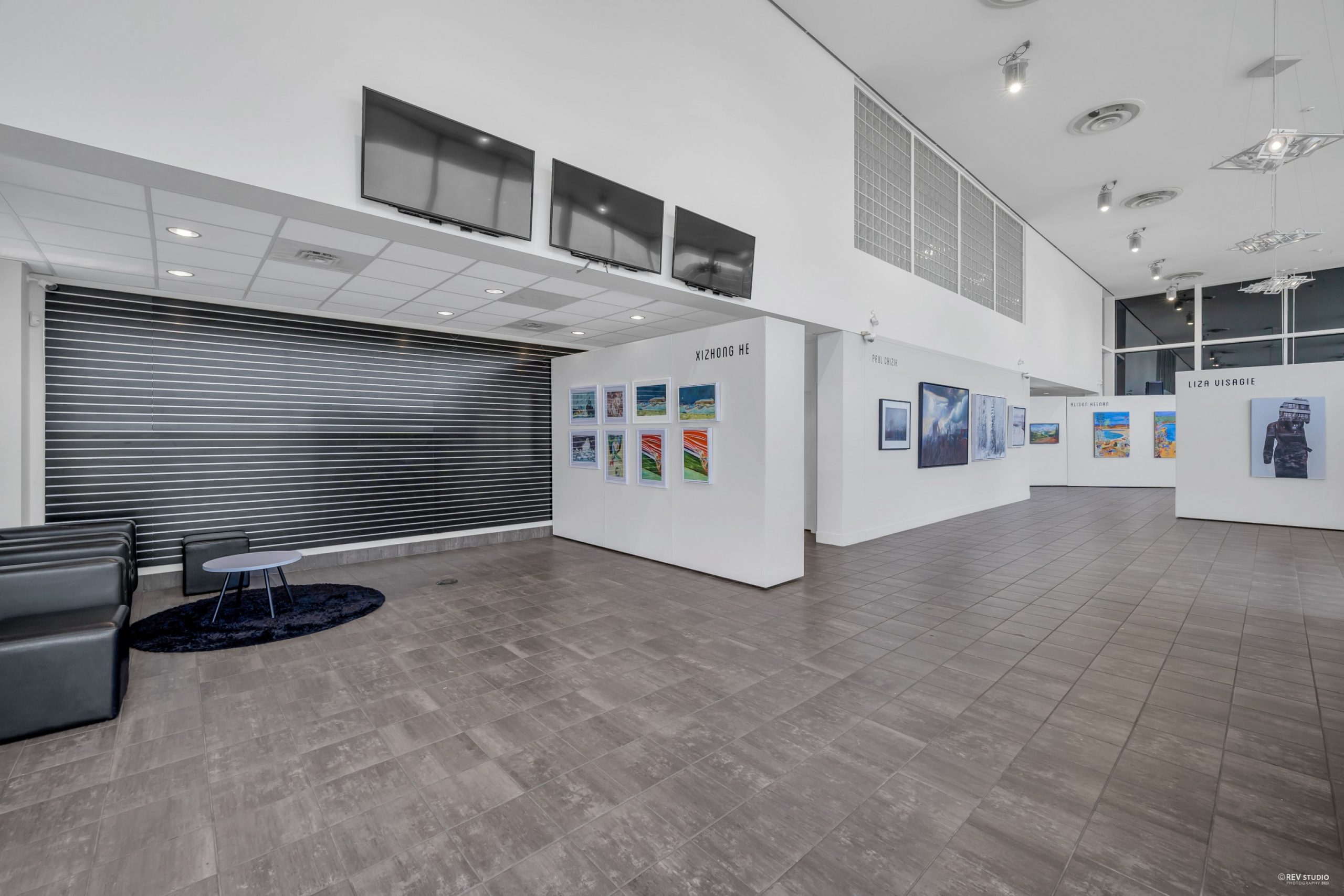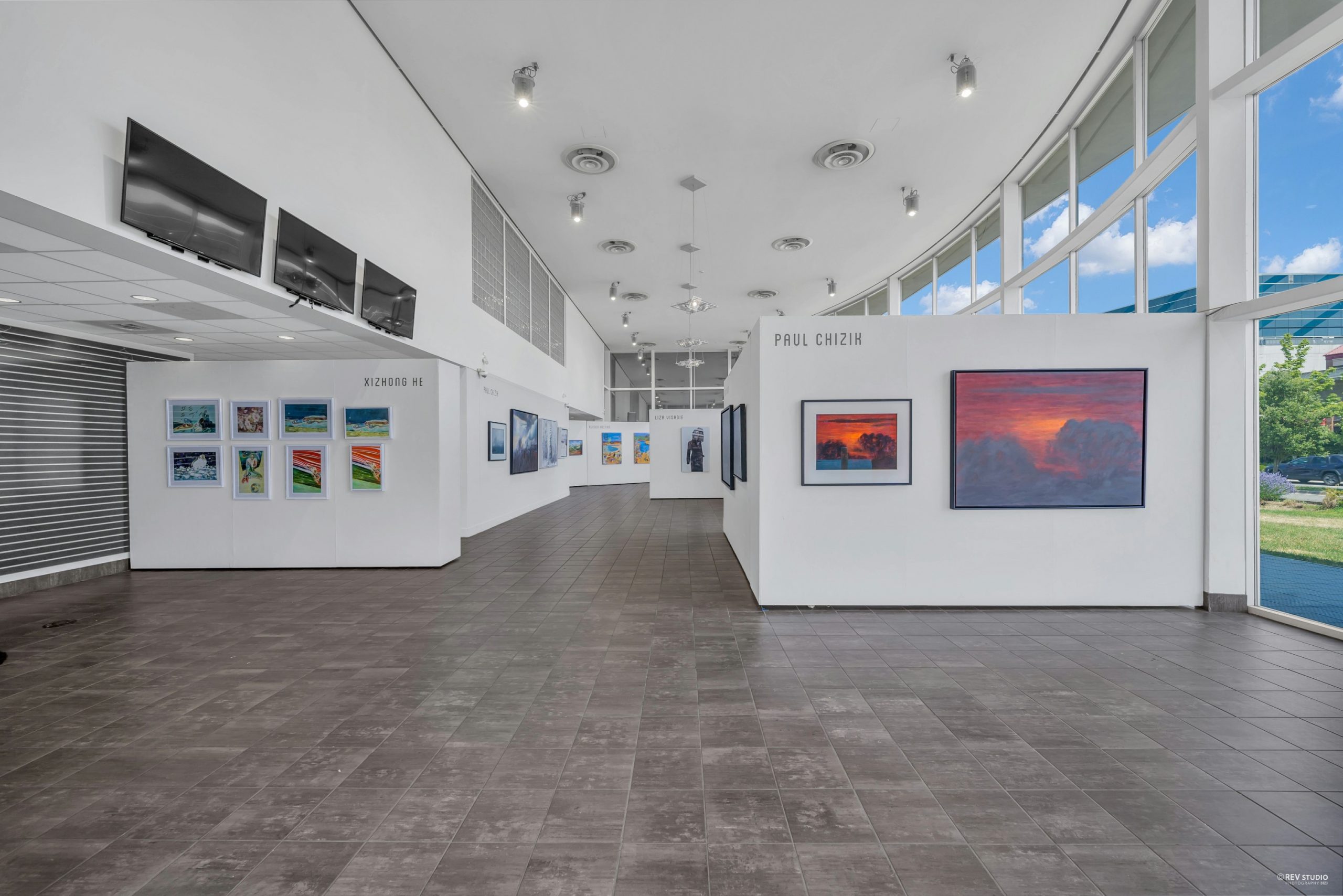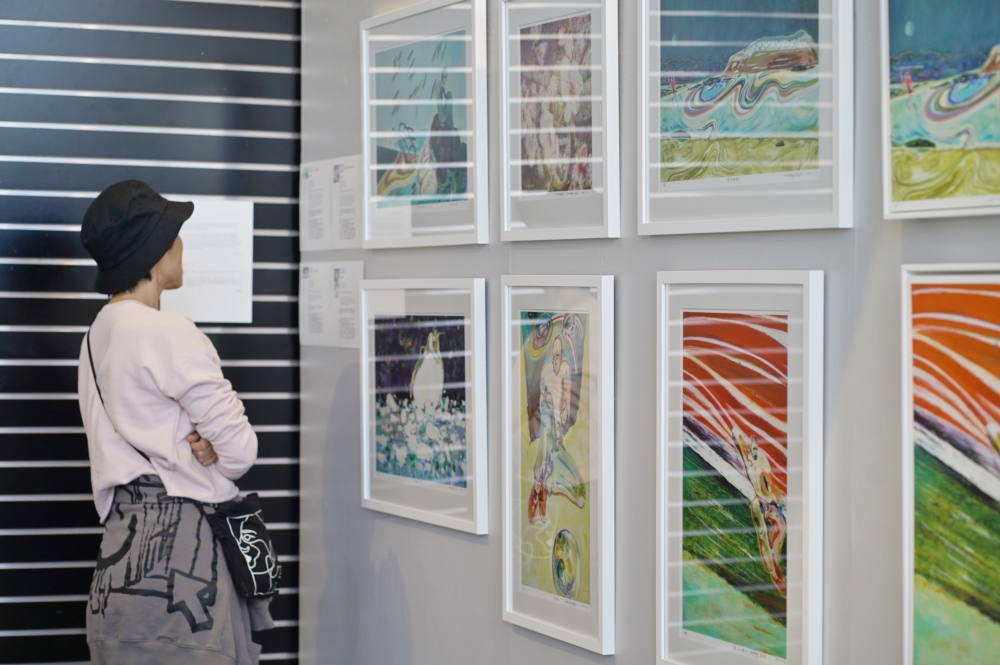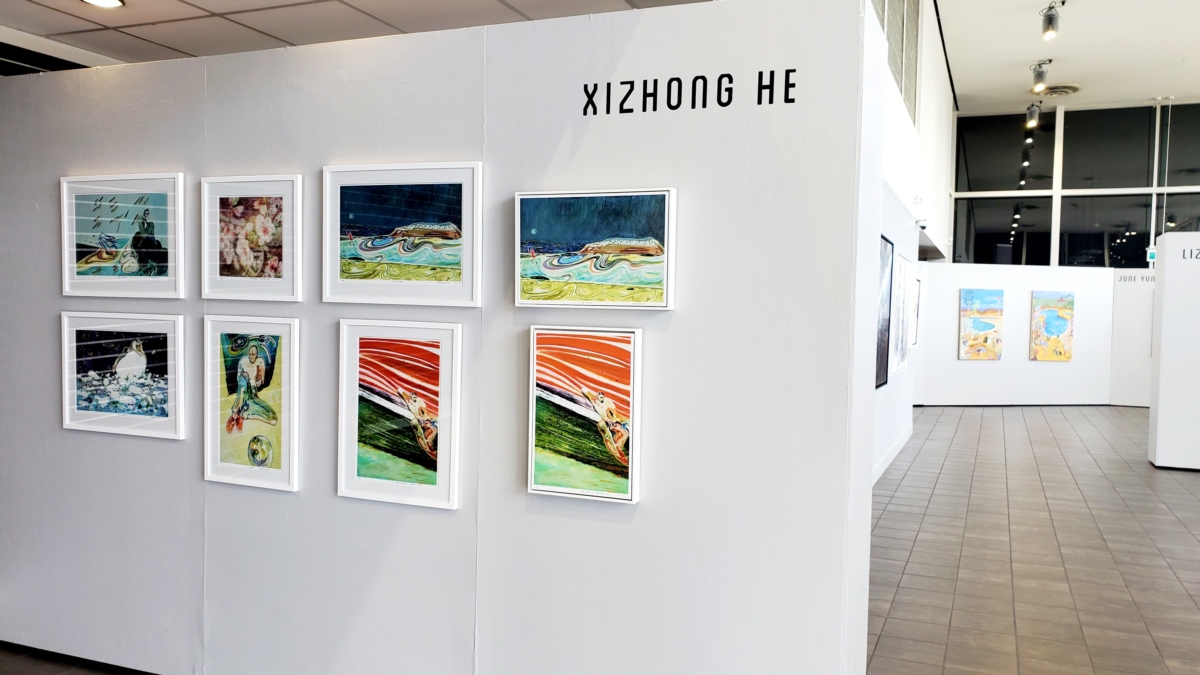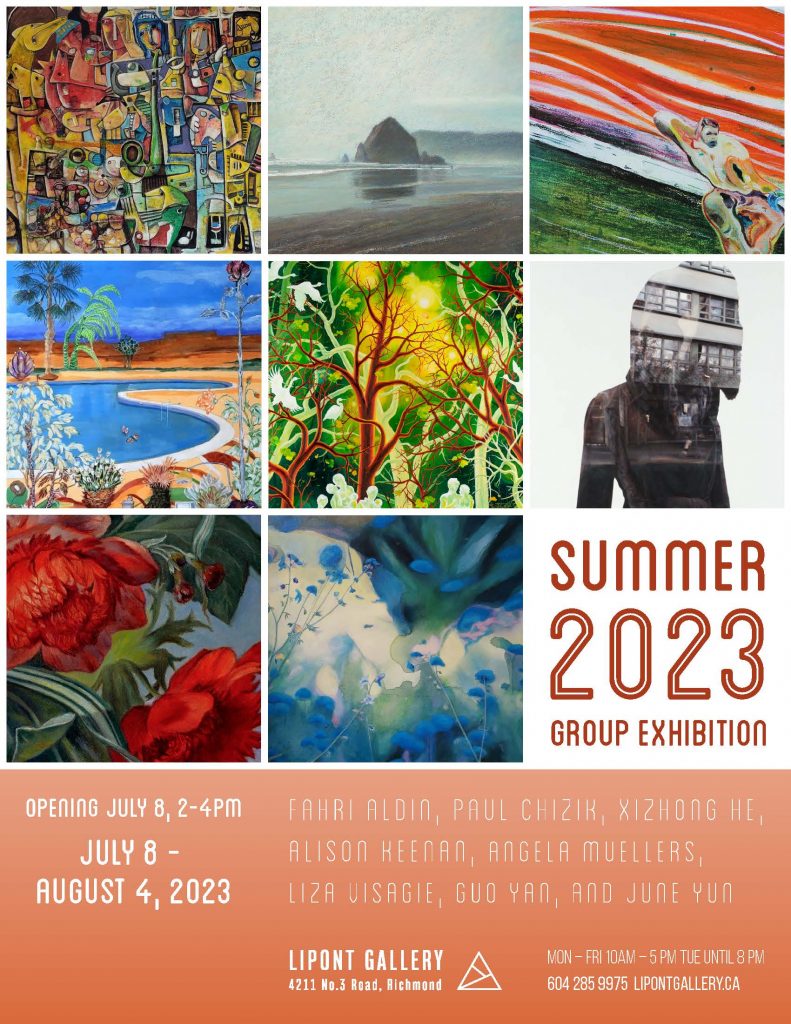Xizhong He
born 1975 in Guangshui, Hubei, China
Education
1999-2002 MFA in Oil Painting, Hubei Institute of Fine Arts
Work Experience
2002-present Associate Professor, Beijing Institute of Graphic Communication
Member of Society of Advanced Art Education, ECPA
Member of Beijing Artists Association
Artist Statement
I pay attention to the current social life and psychological state of people, explore the image art language as much as possible to touch the human thought dimension, and promote the expression and exchange of ideas.
The direction of visual communication design is an interdisciplinary system, and artistic aesthetics and cultivation are the further improvement and promotion of visual system knowledge. The promotion of art accomplishment is the result of extensive contact with existing design thinking and continuous accumulation of self practice. It is an effective way to improve professional knowledge to study the conversion thinking, conditions and methods between reality and art design, cultivate the ability of self discovery and perception, and improve the skills of practical operation.
Teaching
Sketching, colour theory, composition, graphic design, and illustration
Research Direction
The expression of artistic language and creative thinking
Solo Exhibition
2011
Personal Microscopic View, A Solo Show of Oil Paintings by He Xizhong, Beihang Art Gallery
Group Exhibitions
2023
Lucid Water and Lush Mountains, Exhibition of Landscape Sketches by Beijing Famous Oil Painters, Beijing
The Praise of The Harvest, Invitational Exhibition of National Famous Artists, Beijing
2022
Rabbit Hole, Yuanuniverse Art Festival, Cloud Activity APP
2021
The Second Five-School Joint Exhibition of “Spring and Autumn”, Beijing
Participated in the “Second National Excellent Art Works Exhibition of Teaching Practice of College Teachers” hosted by the Higher Art Education Branch of the (National) Education Calligraphy and Painting Association in Guizhou
2019
Vocabulary International Design Exhibition, Gallery IANG, Seoul, South Korea
The 7th Art Fair of Jinan, Jinan International Exhibition Center, Shandong Province
2018
Education review exhibition of Beijing Institute of Graphic Communication, Beijing Institute of Graphic Communication
2017
Painting Confluence, Wuhan
2016
Nian Shi Hui, Wuhan
2014
Imagery in Poetry Chinese Landscape Oil Paintings Exhibition, Shandong
Beijing Images-Magnificent Fengtai, Beijing
‘Intergration/Condtruction’ 2014 The Fifth Contemporary Art Invitation Exhibition of Beihang Art Gallery
2013
The 12th session of new Artists and Works exhibition in Beijing, Beijing
Collection of works
2019 ‘Fragments of Poetry 1’ Collected by Gallery IANG, Seoul, South Korea
Publicity
2011
What Draws He, published by Printing Industry Press
2023
Keywords in Printing Preprocessing and Image Creative Design, published by Beijing Art & Science Electronics Press
何喜忠
1975 年生于中国湖北省广水市
教育背景
1999 年-2002年 学习于湖北美术学院 // 油画专业
2002 年 毕业于湖北美术学院 // 油画硕士
2012 年 -2013年 清华大学美术学院
工作经历
2002 年至今 任教于北京印刷学院 // 副教授
高等美术教育学会会员
北京美术家协会会员
艺术创作认知
关注当下社会生活和心理状态,以图像艺术语言的探索尽可能触及人的思想维度,促进观念的表达与交流。
教学
主讲课程: 素描、色彩、构成、图形设计、插图
研究方向: 物像的艺术语言表现可能性研究、设计思维与方法研究
教学思考
视觉传达设计专业方向是一个交叉学科较多的体系,艺术审美和修养是对视觉系统知识的再提高和促进。艺术修养的提升是广泛接触已有设计思维和不断自我实践积累的结果,研究现实与艺术设计间的转换思维、条件、方法,培养自我发现和感知的能力,提高实践操作的技能,是提升专业知识的有效方法。
个展
2011年 “一个人的微观”何喜忠油画作品展,北京航空航天大学艺术馆
联展
2023年
“绿水青山”北京油画名家风景写生作品展// 北京
“丰收的礼赞”全国名家美术作品邀请展// 北京
2022年
“兔子洞”元宇宙艺术节//“云活动”APP
2021年
“春华秋实”第二届五校联展 // 北京
(全国)教育书画协会高等美术教育分会在贵州主办的“第二届全国高校教师教学实践优秀美术作品展” // 贵州
2019年
“字汇”国际设计联展 // 韩国首尔IANG 美术馆
第七届济南艺术博览会 // 山东济南国际展览中心
2018年
北印教育回顾展 // 北京印刷学院美术馆
2017年
“绘合”A3艺术计划第四回 // 湖北美术学院美术馆
2016年
“廿十绘”A3艺术计划第三回 // 湖北美术学院美术馆
2014年
“北京意象·丰台华彩”绘画作品展 // 中国美术馆
“可见之诗”中国油画风景作品展 // 山东潍坊国际会展中心
“融合·建构”2014 第五届北航艺术馆当代艺术邀请展 // 北京
2013 年
北京第十二届新人新作展 // 劳动人民文化宫
收藏
2019年《散落的诗意-1》被韩国首尔IANG美术馆收藏作品
专著
2011年 《何形何色》印刷工业出版社出版
2023年 《印前关键词与图像创意设计》北京艺科电子出版社
作品链接
Artist Statement
艺术与教学思考
关注当下社会生活和心理状态,以图像艺术语言的探索尽可能触及人的思想维度,促进观念的表达与交流。
视觉传达设计专业方向是一个交叉学科较多的体系,艺术审美和修养是对视觉系统知识的再提高和促进。艺术修养的提升是广泛接触已有设计思维和不断自我实践积累的结果,研究现实与艺术设计间的转换思维、条件、方法,培养自我发现和感知的能力,提高实践操作的技能,是提升专业知识的有效方法。
The Self-Sufficiency That Blooms in The Dirt
Xizhong’s oil painting style is free and stretched, and his brushstrokes reveal his talent. Among them, his peach blossom paintings are particularly unique.
Xizhong is constantly depicting peach blossoms. Peach blossoms are very characteristic of Chinese culture. There was a Peach Blossom Garden in the Jin Dynasty, a Peach Blossom Fan in the Ming Dynasty, and a Taohuawu (Peach Blossom Dock) in Suzhou, China. Peach pink and pink green are often paired together, which is not only very Chinese but also very folk. Peach blossoms appear on the costumes of opera actors; on the decorations on the kang (heated brick bed) in the north; on the flower and bird paintings on oilcloth umbrellas and boxes; on the plastic covers of diaries; and on the footage of news documentaries.
In other words, these are the visual experiences of people who lived in the 1970s and 1980s. Xizhong grew up in that era, and naturally carried the information of the times and his homeland. The surrounding objects cultivated his visual experience and influenced him subconsciously. There is a kind of paper fibre texture in his paintings, which makes the objects in the paintings a bit blurred, a bit like myopia or double vision, and like the movie stills pasted in rural rooms in the past. At that time, no one had a few “Liu Sanjie” And “Ashima” movie comic book prints, as well as star calendars such as “Little Tigers” and “Jimmy Lin”. The printing quality was not so good, coupled with the long-term fading, the effect of virtual edges or ghosting, subtly exists in people’s minds, and maybe the memory of this image will wander out on its own in the future. In Xizhong’s 2022 oil painting Forms Translating into Peach Blossoms, all visual memories and experiences are harmoniously combined unconsciously: the red colour of peach blossom rushes out of the edge of the flower, sprays and dyes the sky and branches in the sky. This scene is very similar to the peach blossoms in full bloom on the North China Plain. Under the loess-toned sky unique to the dusty weather, it is both pink and willow green, and the sky is dark. In his 2014 painting Autumn Flowers Will Be Gone, you can feel the dry texture like the land. The image seems to be printed on a piece of leather or horse dung paper. The painting is full of grass stalks, debris, and fibers. Unfortunately, the texture of earthen paper can only be found in the countryside, so Xizhong’s paintings are very folk. At the same time, the peach blossoms in the painting are rich and colourful, blooming naturally and freely, just like the girls in the mountains, growing their own charm on their land.
When it comes to being natural, Xizhong is lucky. During his professional education in painting, his teachers did not suppress or transform his natural aesthetics, and inspired and protected his original aesthetic experience. In his works, he can naturally reveal the habit and state formed over the years. This is called “self-sufficiency” in Buddhism. The original self is born with perfection. This perfection is a state and a kind of self-suggestion, this kind of art education brings people’s liberation rather than confinement, so Xizhong is lucky to have such an educational experience. After leaving the school, he continues choosing the theme of his works independently and adjusting them. The state of practice seems to be unrestrained, but in fact, each stage has its own goals, and it is constantly approaching the realm he pursues.
I like the peach blossoms by Xizhong, which I call them “the self-contained blooming in the soil.
Yousong Li (李尤松)
April 3, 2023
土坷垃里盛开的本自具足
喜忠的油画风格自由而又舒展,笔触间流露出他的才情,其中他画的桃画尤其与众不同。
喜忠不断在描绘着桃花,桃花是极具中国文化特征的物象,晋代有桃花源,明代有桃花扇,苏州有桃花坞,桃粉和粉绿色常常搭配在一起,不但特别中国而且特别民间。桃花出现在戏曲演员的服装上;出现在北方大炕上的装饰上;出现在油布雨伞的和箱子上的花鸟画上;出现在日记本的塑料皮上;出现在新闻纪录片的镜头上。
说来这些都是生活在上世纪七八十时代人的视觉经验,喜忠就成长于那个年代,自然也携带着时代和故土的信息,周围的物象培养了他视觉经验,在潜意识里影响着他今日的创作。他的画作里有一种纸纤维一般的肌理效果,使得画中物象有点模糊,有点像近视或重影的视效,又像过去农村房间里贴的电影剧照,当时谁家没有几幅《刘三姐》和《阿诗玛》电影连环画印刷品,还有《小虎队》《林志颖》这样的明星挂历。印刷质量本来就不佳,再加之年久褪色,而产生的虚边或重影的效果,潜移默化地存在于人们的头脑里,说不定在日后的那一天这种图像的记忆会自己溜达出来。在喜忠的油画2022《形译桃花》中,一切的视觉记忆和经验都在不知不觉中和谐地组合在一起了:桃花的红色冲出了花朵的边缘线,喷洒浸染到天空上和枝条上,这个景象非常像华北平原上盛开的桃花,在浮尘天气所特有的黄土色调的天空之下,既桃红柳绿,又昏天黑地。在2014《秋艳花将逝》一画中又可以感受到如土地一般干燥的肌理,物象好像被印在一张皮纸或马粪纸上,画中充满了草梗儿、碎渣儿、纤维和芥蒂,这种土纸的质感只在乡下才有,所以喜忠的绘画很民间。同时画里的桃花是浓艳的,自然自在地开放着,宛如山里的姑娘,在她们的土地上生长出自己的风采。
说到自然而然,喜忠是幸运的,在他接受绘画专业教育的过程中,他的老师没有去打压或是改造他从小自然而然形成的审美观,并且启发和保护了他原发的审美经验,使得他在作品在得以自然流露出经年形成的习惯和状态,这在佛家叫“本自具足”,本来的自我天生所具备的圆满,这种圆满是一种状态,是一种境界,也是一种自我暗示,这样的艺术教育带来的是人的解放而不是禁锢,所以喜忠有这样的教育经历是幸运的,在走出校园之后,他也是在独立地选择作品的主题,调整自己的创作状态,看似信马由缰,其实每个阶段都有自己的目标,不断向自己所追求的境界靠近。
我喜欢喜忠画的桃花,我称之为土坷垃里盛开的本自具足。
李尤松
2023年4月3日
The pattern and parable of life —— Enlightened by recent oil paintings of He Xizhong
By Shao Jun
Translated by Shao Chang and Liu Yang
According to the book, “Feeling and Form” written by Susanne K. Langer, we learn that despite various kinds of styles and formats of art, the artists’ own specific life experience, the inspirations and the hesitancies towards life and universe, as well as the home of their artistic souls are highly likely to have an effect on their creations. He Xizhong is such an estimable artist who has the mastery of combining his talent, understanding of life, and form of arts with his artistic form and concept, capable of both merging the elements of his life form and activities with a popularity which is vague but in vogue and focuses more on our society and perceptions.
These groups of He Xizhong’s paintings indicate his unique value in art clearly, which can be reflected mainly in the following two aspects:
On one hand, the form of his painting, the symbols he uses and the style of his language show others his unique personality. As we know, since the emergence of modernist art, patterns and symbols have been adapted to be utilized in modern oil paintings by artists. Especially for the contemporaries, it is a common habit that patterns and symbols are supposed to be involved in art creation. Undeniably, patterns and symbols themselves convey a strong sense of culture, which may bring into the creations particular “social information”, and then add “value” and “significance” to the art. Nevertheless, we are also expected to understand that it is only the innate characteristics of art that expresses the artist’s thoughts, emotions and their creativities embodied by their creation’s patterns and symbols that can disseminate human feelings to the public. What can be found delightedly from He Xizhong’s paintings is that he makes such efforts in most of his paintings like Loneliness blue, Self-depiction and Vague outlook Loneliness blue and Self-depiction absorb strategies and methods of drawing from Cubism in order to explain the figures and symbols, and then rebuild them by explanation. This way of constructing figures seems related to early Cubism, whereas we can see some notable differences. The symbols look obvious but also obscure. A few specific figures and symbols are concealed ingeniously by the artist, in order to provide us with his original understanding. He Xizhong’s, superb drawing skills and the achievement in his new exploration of settling art expressions and art symbols are usually revealed unintentionally in his works, for instance, by variable nude body symbols in Loneliness Blue, modern technological touch in Able Man and the composition of cosmos realization and Zen in Passing by Loneliness. We are living in a community which necessitates not only discussion of many problems about life, like bodies, technologies and the information era, but some abstract questions as well, like the meaning of life, loyalty, faith and other abstruse philosophical thinking. Everyone is affected by this situation with no exception for artists. But there is no doubt that the airs of tranquility with which artists represent their lives and their speculation is consummate with pure art. Hence forth, their works have cultural significance and artistic value in the contemporary age.
He Xizhong has the ability to make the visual pattern. Paintings like Slightly intoxicated, which has the variant and the process of plane enclosed by lines that constantly used by He Xizhong reminds people of Francis Bacon, whose masterpieces are once reviewed with the concept “tactile vision”and “pure image”. Anyhow, it is evident that He Xizhong’s exploration of pure impression about using patterns and symbols in drawing will exert a profound and lasting influence on his own way of oil painting. Also, the color of He Xizhong’s paintings is also a distinction besides lines. It can bee seen from his paintings that the flat color technique, whose purity occupies a large portion, is not scarce in He Xizhong’s work. In addition, this drawing technique can usually be found similarly in Chinese traditional folk drawings although the two styles of drawing have very different effects and meanings from each other. The change in visual intensity of the color itself and strength of tension reflected by the flat color procedure indicates a unique glamour of color using — color becomes the frame and main structure. Directions of flat color, conflictions of colors, and the fusion and the deviation of lines come together to form the artistic expressive power of color in He Xizhong’s paintings. Here, we could understand the three vital elements of life’s pattern in He Xizhong’s oil paintings. Symbols, lines and colors, these three factors are created by the artist originally but all have conspicuous characteristics of their own.
On the other hand, the spiritual power shown in He Xizhong’s paintings is also from his descriptions of life’s parable. There can be two major types of this batch of paintings in accordance with what the subject is: one is about humans, the other is about animals and plants (and few still objects). Not only did these paintings make some creations on pattern, but also a cryptic spiritual power. For example, the environment of deluge that people are struggling to survive in Passing by loneliness. This kind of feeling that the environment is terrible but it is always not enough to overshadow the courageous and the everlasting hope of surviving is the common aim of many artists. Furthermore, the paintings about animals and plants, especially the set of Falling into this world, give emblematic descriptions to us all and think aloud that which is a speech about not only universe, the society and life, but self-awareness and attitude towards culture and value as well. This kind of expression is full of symbolism and tortuousness, and very similar to parables
He Xizhong depicts himself as a spirit falling into this world and loving legends. These could somehow convey his thoughts and ambitions. Imagination is an artist’s illness; but without it, a man may never become a real artist. Some people may convert the imaginary world into the cruel behaviors in reality, while some others are still intoxicated in the art world of their own dream. We are always trying to figure out who we are and where our spiritual homeland is, perhaps that’s why they need to pick up their pens to trace the lost “me” and all the stories about “me”.
Artists use an introspective way to state their spiritual land instead of romantic colors or bizarre ideas, trying to build up some symbolic parables. Horses, dogs or other animals; trees, grass or flowers, probably all of these images in the pictures have some symbolic meanings; however, provided you regard the art works as symbolic as poems, you will realize it is obviously too simple; or maybe they can be treated as parables? No, they can’t. Parables are specially designed for symbolism but symbolism only exists in paintings as implications: the arrogant gallant horse is wandering in the mysterious space of chaos, the alluring fox is glancing back attractively with a smile, the tiger king is escaping fearfully seeing his ruined home and the monkey and the frog are still on the way of their talk for centuries after centuries…, the spiritual power of all of these pictures is not only delivering the lives and ideas of the artist, but conveying another lifestyle and happiness existing in the artist’s own spiritual world. Artists’ concepts of living and the philosophy of living can be shifted efficaciously in this way. I would just like to call this sort of painting a characteristic “parable”. This parable is the other aesthetic value in He Xizhong’s art work and this is also avoiding the painting becoming simple narratives or unreasonable grumbles. Despite this, the parable helps the paintings to show its appropriate techniques and high quality.
A group of his paintings with red background are exceedingly compelling. These pictures enclose a round figure in red, inside the circle, a space without time and sequence is molded by pure white color wandering the word of parables and symbolism. The obvious contrast between lofty propylene and absurd images in his paintings never fails to fascinate people to dig out its theme. Animals, plants and reassembled physical symbols are incarnations of parable in several paintings about humans in Falling into this world.
From an overall perspective, the exceptional aesthetic property of He Xizhong’s paintings, which can be considered as an aesthetic characteristic emphasizing meaning through image if we take it into a Chinese traditional way of drawing. This could help us to understand his oil painting creations.
These paintings are only recent accomplishments of He Xizhong in his various explorations, But to some measure, the diversity and flexibility of his drawing style and the selection of themes in his performance can be discovered apparently, which is undeniably worthwhile and is supposed to be encouraged for young artists. In spite of this, He Xizhong also demonstrates the consistency in artistic cogitation and concept during all the variations in paintings. All the explanations above are not only about He Xizhong’s work, but also a way to understand his temperament revealed in his art creations. Personally speaking, I trust that his oil painting is in a right way and he finds his own direction for his future. I wish him to gain ever more and greater success in the future.
生命的图式及其寓言性——读何喜忠油画近作
邵 军
苏珊·朗格在她的《情感与形式》一书中谈到艺术家的生命形式时说:“(艺术创作)必须使自己作为一个生命活动的投影或符号呈现出来,必须使自己成为一种与生命的基本形式相类似的逻辑形式”,我们也可以说,虽然艺术的样式与面貌多种多样,但艺术家在营构自己的艺术世界的时候,往往都从其中流露出属于自己的特有的生命形式。它既是艺术家对宇宙人生的感悟或彷徨,也是他们艺术灵魂安身立命的精神故乡。在当代艺术普遍关注社会关注意识的时髦而空泛的潮流中,那种能将艺术家的生命活动及其形式溶入到当代艺术的观念语境之中的艺术创作,显得尤为难能可贵。何喜忠就是这样一位将自身的禀赋、生活的悟得和艺术的精神融会在其艺术语言形式和观念之中的艺术家。
摆在眼前的这几组作品清楚的呈现了何喜忠在他的油画创作中所体现出来的独特魅力和艺术价值。这主要体现在以下两个方面:
一是何喜忠油画中所使用的图式和符号及其语言形式,呈现出独特的个人属性。我们知道,当代油画有好用图式和符号的习惯,这是自现代派以来就已经流行的,特别是在当代艺术的文化语境中,更是成为一种创作上的“自觉”。毋庸讳言,图式和符号本身具有某种强烈的文化属性,会给作品带来特定的“社会信息”,进而为作品凭添出“意义”和“价值”。但是,我们也应该明白,艺术的创作本质上仍是艺术家一己之精神、情感的外化,只有在其作品的“图式”和“符号”中体现出其自身所特有的、来自本真的创造,才能让其作品撒播出“人情”的力量。可喜的是,我们在喜忠的《蓝色的寂寞》、《自我书写》以及《朦胧的瞭望》等系列中看到了这种积极的尝试和努力。
《蓝色的寂寞》与《自我书写》等系列作品在语言形式上,吸收和借鉴了某些立体派的手段和方法,对画面中的形象或符号进行了某种程度上的“解构”,并在此基础上予以重构。这种构筑形象的方式似乎和早期立体派的做法有关,但我们能够从中看到更大的不同:它重新将形和体块组织在一种形象和符号的完整性之中。在单纯而高调的背景之下,这种形象符号显得既凸显又隐讳。画家将某些特定的形象和符号巧妙的隐藏了起来,而展示给我们他自己的一种体会或理解。《蓝色的寂寞》中变幻而裸露着的身体符号、《有能力的人》中的科技和时代气息、《路过寂寞》中所体现出来的宇宙观与禅意,都清楚的显露了画家在处理艺术语言和图式符号方面的最新探索及其成功和高明之处。身体、科技与信息时代或者人生与信仰以及其它种种,都是当代社会语境下不可回避的生命课题,我们每天都生活在其中并思索着它们,画家也概莫能外。但用自己独特的语言形式,以“纯艺术”的状貌,冷静得不露痕迹地来描述他的生活和思索,来呈现他的生命状态,则无疑其方式是艺术的,其作品从而也就具有当下的文化意义和艺术价值。
喜忠这种对形象和符号的运用所建立起来的视觉图式是明晰的、具体的,但因为其中凝结了着的生命形式,它们又是内在的、蕴藏的。它们或者是生长的,在未完成或在变幻中体现出一种过程的美;或者是运动的,用强烈的“势”的营构或者视点与结构的结合来表达独特的视觉体验。喜忠作品中偏爱运用的线条,以及通过线条围成的面的变形和处理,很令人想起弗朗西斯·培根,比如《微微的陶醉》组画中的画面结构和图式。吉尔·德勒兹在《感觉的逻辑》中用“触觉般的视觉”和“纯形象”这样的概念来谈到培根的作品,正是基于培根作品“以纯形象取代了具象绘画”,或者我们从《微微的陶醉》中也能看到这种所谓的“第三条道路”的意义?无论如何,喜忠这种对自我绘画符号图式的“纯形象”探索,对于画家自身的艺术道路而言,显然具有深远的意义。线条之外,喜忠油画的色彩也有着自己的独特属性。这些作品往往采用了高纯度的平涂手法,这种手法可能与中国传统的民间绘画有几分相似,但其效果和意义是决然不同的。色彩本身视觉强度的变化和在平涂过程中体现的张力强度的变化,体现出了这种色彩运用时的独特魅力——色彩成为一种骨架和结构。平涂的方向、色性的冲突、与线条融合和背离共同构成了喜忠作品中色彩的艺术表现力量。至此,我们可以很清楚的看到喜忠油画中自我生命图式的几个重要元素——形象符号、线条和色彩——都具有显著的自我属性,来自画家的本真创造。
另外一方面,何喜忠油画所表现出来的精神力量,还来自其对生命的寓言性描写。喜忠的这批油画,在题材上主要是两个类型,一是以人物为主,二是以动、植物为主(还有少量的静物)。这些作品,除了自我图式上的创造以外,还总能体现出一种神秘的精神力量。比如《路过寂寞》中的景物与人物融合流露出来的天地洪荒和生命坚强,其景物似极乐而俱寂,其人物形象似梵像而永恒。这种精神的力量,是很多艺术家共同的追求。人物之外,那些以动植物为主题的绘画,特别是《坠入凡间》系列中的作品,更是对自然事物的动物、植物作出象征性的描写,传达出自我言说的境界。这种言说既是对宇宙、对社会、对人生的言说,也是对自身意识、文化和价值的某种态度的言说。这种表达充满了象征和曲折,近似于一种寓言似的描写。
喜忠自己曾说:“我是坠入凡间的”,“在凡间我总有些与凡间的不同”并“喜欢人们神奇的传说”,这或者可以见出他的思绪和理想。幻想是艺术家的病症,但没有这种病症或者还成不了艺术家。有人将天马行空的虚幻世界转化为对现实的残酷表达,有人却在艺术世界里继续做着那个属于自己的梦。“梦里寻君君不在,知君梦里正还乡”,我们总在梦想中寻找着自我和自我的精神故乡,正是因为这样,作为艺术家才需要用自己的画笔去寻找那个失落的自我以及关于自我的故事和传说。
画家没有用浪漫的色彩和奇异的形态去描绘他的精神故乡,他选择了一种冷静而自省的方式,试图建立起某种象征的寓意。画面中出现的动、植物,马、狗或者其它动物,树根或者花卉,也许有某种象征的意味,但如果将之看成诗歌一样的象征主义,则显然是过于简单了;那或者是一个个寓言?不,寓言是为象征而象征的作品,是有意为之而为之的,我们从画家作品中看到的只是象征的意味:自命不凡的骏马混沌于奇异的空间之中、卓然孓立的狐狸充满欲望的回眸、威风八面的山林之王空洞得只剩下皮囊、猴子和蛙继续着数个世纪得对话……,这些画面传达的精神力量不只是在象征画家的生活和观念,而更是通过一种寓言的手法,传达存在于画家精神世界的另一种生活和人生的美好。这种手法把艺术家的生活观念和生命哲学进行了有效的转换,从而表现出对某个瞬间的寓意性的言说。作品中的这一特性,我只能粗浅的称之为“寓言性”。何喜忠作品中的寓言性,正是其作品具有的另一审美价值,因为这种寓言性的存在,作品没有变成简单的陈述或故作神秘的呻吟,而体现出作品在艺术手法上的合理和在艺术格调上的品质。
在《坠入凡间》中,一组以红色为背景的画作显得尤为令人驻目。这组作品用红色围成一个圆形的画面,圆形之中又用单纯的白色塑造出一个没有时空没有秩序的空间,那些充满象征和寓言性的言说便在其中永恒的流转。丙稀的高调与单纯和形象的怪诞与荒谬形成强烈的对比,强烈的吸引观者去追寻其中的主题。在《坠入凡间》中的几幅以人物为主题的作品中,这种寓言性又表现为动、植形象与身体符号的重新编码,拥挤在一起的花卉或动物构成的身体、散落于形象之上的花卉等等,共同拼置出一个缤纷世界,它以身体作为母形,寓言性的展示出另一种美好。《自我书写》则用特定的形象,通过符号化和转义的手法,把一种自我意识加以外化,从而强化出作品的寓言性。
总的来看,何喜忠的油画独特的美学属性,主要体现在其形象运用的生命图式以及寓言性的意味方面。如果我们将之纳入中国绘画美学传统来看,实是重“意象”之营构的美学品格。或者这也可以帮我们来约略理解其油画创作?
何喜忠的这批油画作品,只是其作品多向探索的近期成果,但某种程度上,我们仍然看到他在风格上的多样性,在主题选择以及表现手法上的灵活和多变。对于年轻的艺术家而言,这无疑是值得肯定的。但是,在这种多变中,何喜忠又表现出了其在艺术思维和艺术观念上的一贯和同一。上文从其作品中所作的两个方面的读解,也正是看到其在艺术道路上所流露出的艺术气质。我认为,何喜忠的油画创作,路子是正的,而且也摸索到了自己的方向。衷心祝愿他在艺术的道路上能有更多更好的成果。
庚寅初冬于通惠河畔寓所
Spicy and Glamorous, the Image Has A Voice ——Reading Xizhong He’s Art
by Hu Zhaoyang
Falling into the mortal world! They are cynical and refreshing, walking between the ethereal and demonic realms; they are colourful and gorgeous, Zen-like and bashful, this is how I felt when I first saw He Xizhong’s works. I applaud the sweet bitterness brought to me by the Falling into the Mortal World series and the work of Night of the Mortal World. People often wonder whether the function of art is to warn and to provoke thinking of human suffering? ! The interweaving of reality and fantasy in his works, in He Xizhong’s view, is the foundation of and way of conveying culture, which shows the artist’s wisdom. He Xizhong, who received a traditional education, studied the evolution of art history under the library’s fluorescent lights for seven years. The education he received, and the experience of distress and joy, forged his maturity. Derived from Chinese culture, his works have a unique perspective, and seem to be the interpretation of many legends, which makes his paintings “otherworldly yet down to earth”. Falling into the Mortal World 4-1 seems to me shows people’s tunnel vision. He vividly creates a black hole-like and Zen-like picture for us to ponder. “Zen” refers to the thoughts and awareness of the Buddha’s state of mind. This kind of metaphor, the weaving of meditation, is the painter’s way of grafting and incorporating traditional and contemporary, Chinese and Western cultures. His paintings are colourful, which carries the characteristic of modern art. If you look at the art history, it is not difficult to find the state of mind of contemporary Chinese artists born in the 70s and 80s through their experiences in this colourful world. Of course, He Xizhong, born in the 70s, is one of them. In fact, it is precisely because of these imprints and vivid individual labels branded by modern art that He Xizhong’s works can represent and talk to the present. From his works, we can see his learning trajectory: from Picasso to Bacon, Dumas to Koons, and finally carries the characteristics of postmodern “gaudyism”, so his works are spicy, glamorous and sharp. The spirit of sharp criticism is the power of He Xizhong’s works.
Translation by Zhang Jingjing and Liu Yang.
Proofread by Lipont Gallery
辛辣冷艳 大象有声 ——读何喜忠的作品
坠入凡间!玩世与漜盘、行走于空灵与魔域、缤纷艳丽、禅意而羞涩,这就是我第一眼看到何喜忠作品的感受。我赞许《坠入凡间》系列和《凡间之夜》这些作品给我带来的那种悠悠典雅的伤楚,让人常常疑惑艺术的功用是万象人间苦难的警示与哲思?!显然,现实与梦幻的交织交融,在何喜忠看来那是文化的支撑点和传达的方式,这正是艺术家的睿智之处。受过学院传统教育的何喜忠,经历了七年图书馆荧光灯下艺术历史的演变以及老师们不拘言笑的教导,苦恼与喜悦的经历,铸炼了他的这份成熟。他的作品视角独特,源于中国文化的某种启示,似乎是许多经典传说故事的演绎,让他的画有“不食人间烟火,又食人间烟火”的双意性。《坠入凡间4—1》在我看来就是井中之蛙的那点事情在他笔下便活生生地制造出宇宙黑洞般、禅意切切的意境来,让我们启示与思考。“禅”是指佛缘心境的意念与觉悟,这种隐喻、冥思意图的织入,也许就是画家传统与当代、中西文化嫁接与折衷的思考。他的画色彩艳丽,这正是现代艺术所持有的特性。稍加梳理,不难发现中国当代艺术中70后、80后的艺术作佣者以自身体验——身置缤纷多彩花花世界之中的那份心境。当然作为70后的何喜忠来说也无法躲避。事实上,正因为现代艺术烙下的这些烙印与鲜活的个性标签,才如此能代表和对话于当下。从何喜忠作品中能看出他借鉴与学习的轨迹:毕家索到培根、杜马斯到昆斯,最终呈现出具有后现代“艳俗主义”的特色,所以他的作品具有辛辣冷艳又犀利批判的精神,这就是何喜忠作品的说服力。
胡朝阳
2011年5月3日于武汉昙华林

